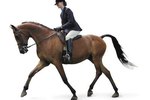
English and Western riders use curb bits for greater control during training. The curb bit is generally considered a severe bit, although the severity of its action depends on the rider's abilities. Riders must have an independent and gentle hand to use the curb bit effectively.
Mouth
Curb bits act on the mouth in two ways. The Mullen mouth curb bit consists of a straight bar that rest on the tongue. When rein pressure is applied, the horse feels it on the bars of the jaw and the tongue. A curb bit with a port has raised bump in the middle of the steel bar that touches the roof of the horse's mouth. When the bit is engaged, the port moves forward, pressing the roof of the mouth while releasing pressure on the tongue.
Poll
Curb bits are called leverage bits because the pressure applied on the bridle headstall increases flexion at the poll. When the horse feels pressure on the headstall and changes in position of the bit, he flexes his head down at the poll, the area of the skull between the ears. Correct flexion is an important step in training horses to collect their gaits.
Chin
Many curb bits have a curb chain or strap attached to the bit. The curb chain has flat links that attach on hooks on either side of the mouth. When the reins are pulled back, the strap or chain tightens on the chin. After horses are trained with the chin strap or chain, they learn to anticipate the rider's movements, and will respond quickly before the strap or chain is engaged to avoid the feeling of it on their chins.
Curb Bit Strength
The action of curb bits varies according to their construction. Mild curb bits such as the Pelham and Kimberwicke use a Mullen-mouth style straight bar bit without shanks, producing a mild action on the mouth, chin and poll. Liverpool bits, used in carriage driving, have a strong action. The most severe curb bits are those with long, straight shanks. The length increases the leverage action of the bit.
References
Photo Credits
-
Jupiterimages/Photos.com/Getty Images
Writer Bio
Jeanne Grunert has been a writer since 1990. Covering business, marketing, gardening and health topics, her work has appeared in the "Chicken Soup for the Soul" books, "Horse Illustrated" and many national publications. Grunert earned her Master of Arts in writing from Queens College and a Master of Science in direct and interactive marketing from New York University.


